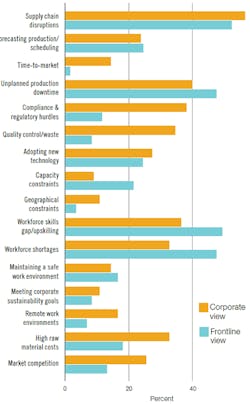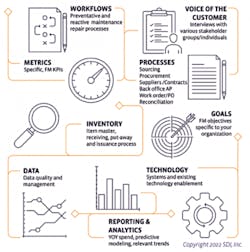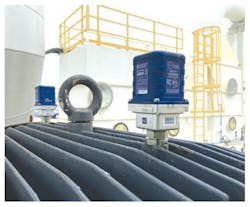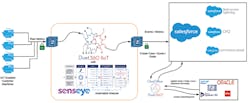When the prolonged period of upheaval in the global supply chain landscape began in early 2020, it brought tried-and-true, and even decently functional, industrial practices into question. One that is under a great deal of scrutiny now is the idea of being “just in time” (JIT) in inventory management and manufacturing.
The methodology aims to squeeze the waste out of workflows and the bottom line, creating greater efficiency, agility, sustainability, and profitability. But if we learned anything from the pandemic, it’s that being too lean can prove risky in unprecedented times.
That’s not to say we should not strive for a highly efficient industrial supply chain ecosystem. Rather, now is the best time to revisit and fortify existing industry best practices. The fundamentals of JIT, Lean, predictive maintenance, strategic sourcing, and the like, remain solid. Nimble businesses are applying them using more modern, resilient, and digitalized approaches. Creative thinkers are searching for new opportunities to innovate brand new best practices.
To help industry achieve its supply chain goals and adapt better to an unpredictable future, solution providers are studying the root causes and developing more-robust methods to prevent or mitigate major supply chain disruptions such as these:
- Unavailable inventory
- Equipment failure
- Excessive costs
- Performance gaps
- Inadequate agility
The December 2021 Machine Maintenance & Reliability Industry Survey from Plant Services and Augury found that both corporate and plant respondents identify supply chain disruptions as the top challenge in their operation today.
Disruptive event: Unavailable inventory
Liquid nitrogen is a key resource in the production processes of a leading food processor/grower cooperative, but a bullwhip effect of the COVID pandemic left the organization without a reliable supply. “Former suppliers had no availability, leaving the company with no alternative sources, no functional equivalents, and no way to meet the demand of their customers for their products,” says Glenn Pierce, VP of Operations at SDI.
SDI, a Supply Chain as-a-Service (SCaaS) provider, helped augment and enhance the cooperative’s indirect materials and MRO supply chain, and together the two companies collaborated on a “pivot-to-adapt” response to ensure availability of the critical resource.
Lessons for industry. The COVID-19 pandemic highlighted the world’s lack of readiness to manage through a global supply chain crisis and the need for digital supply chain management strategies that reduce our reliance on off-shore suppliers for crucial parts, components, and materials, notes Pierce. And when shortages because of lockdowns and continued uncertainty were followed by a surge in product demand as the economy started to bounce back, the supply chain was not able to meet the demand.
“Disruptions in production, transportation, and logistics highlighted the importance of redundant supply sources, manufacturing agility, and data accessibility. Digitization and automation of both the direct and indirect supply chain is now a must,” observes Pierce.
To help ease the pain, SDI recently announced that its Supply Chain Risk Report with actionable insights and recommendations is now available to maintenance and facilities management (FM) professionals, whether they work with SDI or not, to help identify solutions that can alleviate challenges and improve overall supply chain performance.
The Supply Chain Risk Report is now available to maintenance and FM professionals, whether they work with SDI or not. (Source: SDI)
Additionally, the company is opening up access to its 24/7 Remote Buy Desk. Normally provided as part of a broader as-a-service offering, the Buy Desk can now be used on demand by facilities managers and plant maintenance teams that need firefighting assistance now to get their plants or assets back up and running.
Disruptive event: Equipment failure
A catastrophic failure on a gearbox on a concrete product production line occurred late one evening at the height of the pandemic, when the global supply chain for building materials was constrained and material prices were very high. Out of necessity, the large building material company had been running the critical production line 24/7, at full capacity, and any downtime on the line was unthinkable.
Their director of reliability determined there was no replacement gearbox in inventory across any of their plants and the lead time to acquire the component from overseas was potentially three weeks. What’s worse, the concrete already on the production line solidified, and the whole team had to spend eight hours jackhammering solid concrete from the line.
“With AI-driven machine health, reliability and operations teams know about emerging failures weeks in advance and know exactly what to do.” (Source: Augury)
“The director told us that that single event led him to invest in machine health, and Augury in particular,” says Artem Kroupenev, VP of Strategy at Augury. “With AI-driven machine health, reliability and operations teams know about emerging failures weeks in advance and know exactly what to do to eliminate issues early and in a way that does not disrupt the production schedule.”
Lessons for industry. Since machines are at the heart of manufacturing and manufacturing is at the heart of the supply chain, when machines break, manufacturing breaks, observes Kroupenev. In a global pandemic, a higher emphasis on manufacturing efficiency is needed because even small disruptions can cause major delays, inventory gaps, and missed shipments.
“In extreme cases, the supply chain could be affected by a single failure. Even when failure is not catastrophic, multiple small failures add up to waste, underperformance, overutilization of energy, decreased capacity, and ultimately affects the efficiency and sustainability of the supply chains overall,” he explains.
Kroupenev recommends manufacturers improve supply chain resilience by taking these four steps:
- Deploy AI/IIoT to make sure unexpected machine failures like the one described above do not happen.
- Share insights around the real-time health of machines and production processes across the organization.
- Share insights across the industry.
- Establish a standard for collaboration across industries.
Disruptive event: Excessive costs
A grinding machine manufacturer was losing sales because of a 26-week lead time for inventory. A manufacturer of routers and servers missed its revenue goal by about $400 million when its sole supplier of power cords could not deliver on time. Another company increased its inventory from $20 million to $100 million to mitigate the supply chain crisis but increased the risk of unused parts becoming obsolete.
Downtime costs are similarly challenging. If one asset fails on an assembly line, the whole line goes down. If a machine experiences more than the downtime allowed in the SLA, the service provider will be assessed a penalty. If a major automaker is fine with 86% uptime, they are easily leaving at least $50-60 million on the table every year.
“This past year has probably been the worst ever for supply chain planning and management. There is a lot of friction because asset failures can take weeks or months to resolve, and that impacts revenue and business health,” says Rob Hienekamp, CEO of Endowance Solutions.
Senseye’s machine health analysis feeds Duet360 IIoT, launching an integrated supply chain response. (Source: Endowance Solutions)
Lessons for industry. Automating supply chain activity to proactively replace failing assets or parts based on real-time events increases asset uptime and allows manufacturers to focus more on manufacturing. That is Endowance’s goal as it works to help companies monetize servitization through aftermarket parts and service contracts with its Integrated Asset Condition Performance (IACP) solution.
The company established a strategic partnership with Senseye, whose industrial predictive analytics use AI and machine learning to predict when an asset needs repair or replacement. “They send the alert, and we answer the ‘What’s next?’ question,” Hienekamp explains.
Senseye calculates an Attention Index based on an asset’s behavior patterns, criticality, and the production schedule, and feeds it to Duet360 IIoT from Endowance. From there, an integrated supply chain response is initiated, including an automatically triggered service case, customer notification, quote, order, shipment, and invoice if not covered by a support contract. Third-party logistics (3PL) integration is also planned.
“The more we can measure, the more we can reduce friction in the supply chain and increase our customers’ asset health, uptime, lead times, inventory levels, and business health. I also think just-in-time parts is a concept that is going to have a huge impact on company health,” adds Hienekamp.
Disruptive event: Performance gaps
Global supply chain disruptions spawned by the pandemic created widespread headaches that are yet to fully subside. Personnel are still falling ill, changing jobs, or retiring; supplier product shortages remain prevalent; critical inventory is stuck in backlogged ports and freight terminals; and lead times are often higher than normal. For manufacturers navigating the challenges, third-party service providers are meeting the needs of the moment with sharpened solution portfolios.
The MRO supply chain includes essential items used frequently in the plant or in the field, but not built into manufactured products the way direct materials are. (Source: Advanced Technology Services)
For instance, a major consumer packaged goods (CPG) manufacturer outsourced its repairable parts management to Advanced Technology Services (ATS) and gained extended asset life, greater sustainability, and $377,000 in cost savings over 18 months. A railcar manufacturer gained quick ROI from ATS’s machine health monitoring solution that prevented a $5,200 motor and $14,000 blast wheel assembly from failing, and avoided lost production time, rushed parts costs, and expensive emergency repairs.
Lessons for industry. Many companies have robust direct procurement processes built into their enterprise resource planning (ERP) systems but treat indirect procurement as an afterthought. “This is counterproductive, though, because inadequate indirect processes and systems can threaten operational performance and supply chain resiliency,” says Mike Waltrip, VP of Operations at Advanced Technology Services.
Indirect materials are part of the maintenance, repair, and operations (MRO) supply chain and include essential items used frequently in the plant or in the field, but not built into manufactured products the way direct materials are. “We focus almost exclusively on indirect MRO spare parts and inventory to support our maintenance and storeroom services business and maximize our customers’ operational continuity and output,” explains Waltrip.
A digitalization initiative that delivered enhanced visibility and transparency to ATS’s MRO supply chain was fortunately completed before the pandemic. Previously, without human intervention, the requestor might not know if an item was out of stock, discontinued, or on backorder, or if other delays or issues were affecting the workstream, Waltrip recalls.
Example MRO services that mitigate supply chain crises include parts repair, storeroom management, repairable parts management, calibration, and an online industrial parts store. In addition, technical workforce staffing, training, and maintenance outsourcing services help to fill personnel gaps, and sensor-based machine health monitoring and analysis solutions help to reduce downtime and stress on the supply chain.
Disruptive event: Inadequate agility
Increasing supply chain responsiveness, especially in times of crisis, requires a willingness to apply alternative approaches. Interest in 3D printing, also known as additive manufacturing, is surging in manufacturing. For example, HP and L’Oréal are collaborating to increase the global cosmetics manufacturer’s production flexibility, whether creating new packaging or customer experiences; adapting to changing consumer purchasing behaviors or shifts in production lines; or addressing the growing demand for personalized products.
The HP Jet Fusion 5200 Series industrial 3D printing solution is a platform for volume production. (Source: HP)
For new packaging designs, L’Oréal 3D-prints pucks—the carriers used to stabilize products on a conveyor line—and then validates and fine-tunes a prototype in iterations until it meets the design and quality objectives. Afterward, HP Multi Jet Fusion technology is used to scale up to large-volume production. Improving agility in how its products are conveyed, filled, and labeled resulted in a 33% cost reduction and 66% time savings.
L’Oréal also plans to use HP’s Digital Manufacturing Network of parts providers to scale the pucks across its global supply chain. The ability to efficiently produce parts on-demand, when and where they are needed, will further help to meet its sustainability, scale, and agility goals.
Lessons for industry. The past two years have been a watershed moment for the 3D printing industry, says Guayente Sanmartin, Global Head of HP’s Multi Jet Fusion business. “The benefits of 3D printing are being realized as companies around the world look to bring new products to market faster, improve supply chain resilience, and embrace new business models,” she adds.
Distributed manufacturing, for example, enables local 3D printing of the parts wanted and the quantities needed. This model supports dynamic spare parts initiatives, meaning parts can be produced on demand when needed rather than manufacturing them when the initial good is delivered. It reduces lead times and waste, lowers inventory costs, and gets products to market faster.
For those interested but wanting to avoid an upfront capital expense, HP offers a 3D-as-a-Service (3DaaS) pay-as-you-go subscription model that includes 3D printing systems, supplies, and services.
It’s not a choice
We can hope the supply chain crisis will subside and everything will return to normal, or we can accept the reality that at any point we may be in some level of crisis mode. Planning for that inevitability requires bolstering our critical processes and systems to increase resiliency and agility, while doubling down on best practices such as JIT and predictive maintenance.
This story originally appeared in the March 2022 issue of Plant Services. Subscribe to Plant Services here.







